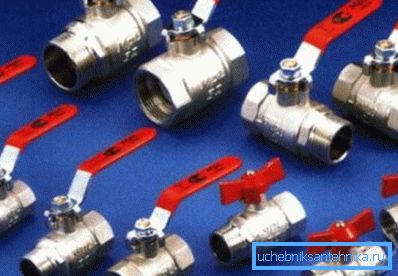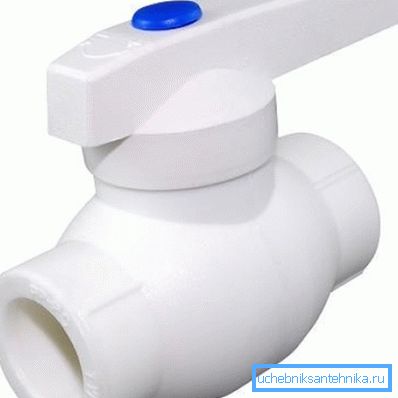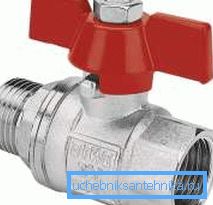Ball valves for plumbing: how they are designed and which
Arrangement of heating and water supply networks in any building can not be imagined without the use of stop valves. At the moment, one of the most modern and reliable cutting elements of such systems are water ball valves. We will talk about all their varieties in our article.

Scopes and design of the ball valve

Ball valves are designed to completely or partially shut off the water supply pipelines.
The most obvious places of their installation:
- section of the mating hose liner toilet and cold water riser;
- point of connection of drainage washing or dishwasher;
- connection node of the heating boiler;
- the section of the heating system that connects to it a “bypass” - (a detour along the circulating pump);
- the cut-off point of the water supply to the whole house / apartment, separately - to the sink, bathtub, sink, shower, etc.
Crane device

- The instruction informs that the mixing ball valve consists of a body and a rotary distributing element.
- This regulating part, in the form of a ball, is hollow inside. There are holes on its opposite sides: two of them are located at one end and one is on the other side.
- Through the first two holes in the device flows cold and hot water. Inside the ball, the jets are mixed and the warm fluid enters the spout of the device.
- Purely locking counterparts also use a hollow ball, but it has only one hole at both ends.
- The diameter of the holes in the circle corresponds to the internal cross section of the supply pipes. Proceeding from this, experts call the ball valve valves “full bore”.
- When the valve is “fully open”, the water hole in the ball closure is as open as possible. When turning the handle of the crane, which means - and the ball, at 90 °, the flow of water is cut off completely.
The advantages of such valves
Before you choose your own water folding or shut-off ball valve, consider their advantages.
- Long trouble-free service life, due to the absence of rubber pads.
- Full tightness - the valve body is one.
- Easy installation. It is only necessary to screw the valve on the output and inlet pipes.
Note! It is undesirable to put ball valves on systems in which water contains a lot of garbage and solid impurities. The locking element in them tightly mates with PTFE linings. Damage to this joint will disable the entire device.
Manufacturing materials
The valves manufactured now are divided into 3 categories according to the material. Before the acquisition should take into account which ball valves are better for plumbing.
Plastic analogues

- For the production of such products used polypropylene or polyethylene of various modifications.
- Such raw materials have absolute immunity to oxygen, electrochemical and chemical corrosion.
- On this basis, plastic ball valves are often mounted on networks that move aggressive chemical fluids.
Note! A significant drawback of polymeric materials is their insufficient resistance to high temperatures. As a result, plastic ball valves should not be used in hot water systems, as well as heating.
Steel devices

- Such shut-off ball fittings are often used in industrial type pipelines.
- It has a special strength, so it is widely used to deliver liquids that are heated to extreme temperatures and even steam.
- Steel ball valves are optimal for use in pipelines that transport liquids under high pressure / pressure.
Brass fixtures

In everyday life, ball valves made of brass are most often used.
- Manufacturers use two methods of their manufacture: casting in molds or forging in mechanical presses.
- The most reliable and durable forged cranes. Accordingly, their price is higher. The reason for the better quality of such products: in their manufacture almost no air cavity is formed.
- The composition of brass includes components that have different electrochemical potentials. As a result, in order to prevent chemical corrosion, the taps from it are coated with an electroplating method, with a special protective layer.
Note! The use of brass ball valves is prohibited in pipeline systems in which the temperature of water or other transported medium exceeds + 150 °. An excessively heated substance creates microscopic cavities in brass. This leads to an increase in material brittleness.
Useful recommendations
- The valve mounted in the water supply or heating network must comply with its technical parameters.. The most important characteristics are the internal diameter of the crane and the maximum hydraulic pressure that it can withstand.
- When choosing a device, carefully inspect it.. On its body there should be no irregularities, cracks, flows of metal. The device must have a complete set of parts and components.
- Before you disassemble the ball valve, carefully study its design. in the attached passport.
- It is easiest to distinguish the valve fabrication material (iron or copper-based alloy) with a magnet. He is attracted only to steel.
Conclusion
Ball valves are very easy to install and operate. They serve for a long time, while providing maximum ease of regulating the flow of water. The video in this article will complement its information.